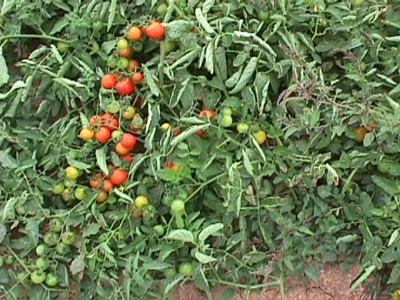Other tomato wilts

We have already discussed bacterial wilt which sees the leaves and growing tip of an apparently healthy plant hanging due to lack of water.
The plant on the left is nearly dead from Fusarium while the one on the right is resistant. Note the discolouration of the conducting tissue in the cut stem in the foreground.
By contrast, the other wilt diseases are totally unlike this and are often not recognised as such, because of their slow progression. When I started growing tomatoes, there were no varieties resistant to these diseases. This made crop rotation a lot more important than it is today.
Verticillium
The first resistances bred into domestic tomatoes were for Verticillium and Fusarium wilt. Nematode and other disease resistances followed. Verticillium wilt is a soil-borne fungus disease with a huge host range, which includes hundreds of weed species. It likes cool weather and needs at least a day of saturated soil to become activated. Any root damage caused by transplanting or even nematodes (eelworm) makes it easier for the fungus to enter the root system.
Brown veins
The first symptoms are a yellowing of the lower leaves. This is followed by brown veins and then dark spots resembling Alternaria but without the rings. The symptoms can also be easily confused with Fusarium. The damage gradually moves up the plant until only the top section remains healthy. Any wilting will only appear as the plant gets old. Fruits remain small and may develop yellow shoulders.
To help with diagnosis, cut vertically through the stem right down into the roots. You should see a brown discolouration of the conducting tissue which can extend up to 30cm from the soil level. The affects above this point are a result of the toxins produced. If you find this disease occurring in your crop, the only practical solution is to ensure that the ‘V’ gene is in the variety you use. This confers a very high degree of resistance to the disease.
Fusarium
Fusarium wilt, by contrast, prefers warm, dry conditions and a soil with a pH of below 5,6. In temperatures of 25°C to 32°C, and especially when roots have been attacked by eelworm, the fungus enters and starts to colonise the vascular tissue.
New races keep popping up and we have Fusarium race 1, 2 and 3 as well as Fusarium crown rot. The symbols used to indicate resistance are usually F1, F2 or F3 and in the case of fusarium crown rot can be Frl or For.
Sometimes Fusarium is abbreviated as I-1, I-2 or I-3. As far as I am aware, F3 does not yet occur in South Africa. With Fusarium, the conducting tissue will be discoloured right through the plant and not be confined to the lower 30cm. The leaves will turn yellow from near the soil and sometimes half the leaf will be yellow. Wilting starts later on in the disease’s development.
Sandy soils
The disease is more prevalent in sandy soils and is also worse where there is a lack of potash and high nitrogen, especially in the ammonia form. Once in the soil, it will be there indefinitely, although long rotations will reduce the severity of symptoms initially. Organic matter can also reduce the severity of the disease. And although they’re not foolproof, you should use resistant varieties as a matter of course if you’ve discovered Fusarium on your farm.
Crown rot
While Fusarium crown rot can also affect tomatoes in the lands, it’s mainly a problem where tomatoes are grown under protection. It’s active at 10°C to 20°C, and symptoms start to manifest when fruits are developing. Chocolate-brown lesions develop on the lower 20cm of the stem, while the root system becomes brown and starts rotting. There’s a yellowing of the lower leaves and the plants start wilting and dying. The conducting tissue will also be discoloured to 20cm from the soil line, unlike regular Fusarium, which shows symptoms right up the plant. Here again, the remedy is to use varieties with the resistant gene.
Có thể bạn quan tâm
 Biological Control of Common Greenhouse Pests - Part 1
Biological Control of Common Greenhouse Pests - Part 1 Some pests in the greenhouse can be controlled by introducing their natural enemies artificially. A range of such biological controls, which may be predatory
 Pests and Diseases of Tree Fruit - Part 1
Pests and Diseases of Tree Fruit - Part 1 Including: apples, pears, quinces, cherries, plums, damsons, peaches, almonds, apricots and nectarines
 Growing Lettuce in Greenhouses and Frames
Growing Lettuce in Greenhouses and Frames The lettuce Lactuca sativa is increasing in importance as a greenhouse crop since the breeding of short-day varieties has made year-round production possible